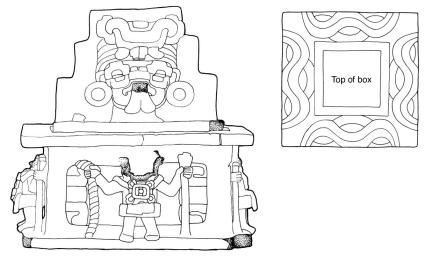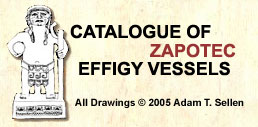| Key: NMAI 1752214 | | Actual Location: National Museum of the Americann Indian, Smithsonian Institution, Washington D.C., United States | | Collection: Louis Gustave Bellon; George Gustave Heye 1928 | | Registration: Box: 1752214.000 (National Museum of the American Indian); Plaster cast lid: PC0089.000 | | Provenance: San Jacinto Amilpas, Center District, Oaxaca | | Measurements: Caja: 18.5 altura; 40 x 37 cm. Tapa: aprox 27.5 alt. | | Color: Grey clay | | Chronology: Xoo 600 - 800 AD | | Click to view Chronology | | Reference: Photograph in the archive of Marshall H. Saville, America Museum of Natural History, Box 27. | | Comments: This box and lid originally belonged to the Bellon collection, but was later acquired by George Heye, apparently without the lid. Based on an old photograph the museum fabricated a plaster cast of the original lid. The whereabouts of the original is unknown.
On the four sides of the box there are figures missing their heads, but it is likely that these had masks of Cocijo similar to the one worn by the head on the box. Also, these figures hold implements in their hands: in the right hand there is a rope, while in the left a kind of scepter, or perhaps a digging stick. | | Glyphs: On the top part of the box a design is drawn on the four borders representing the glyph V (alligator's eye). The pectoral plate is the glyph for "milpa". | |
| | 
Click to view high resolution in a new window
select this image for review |
